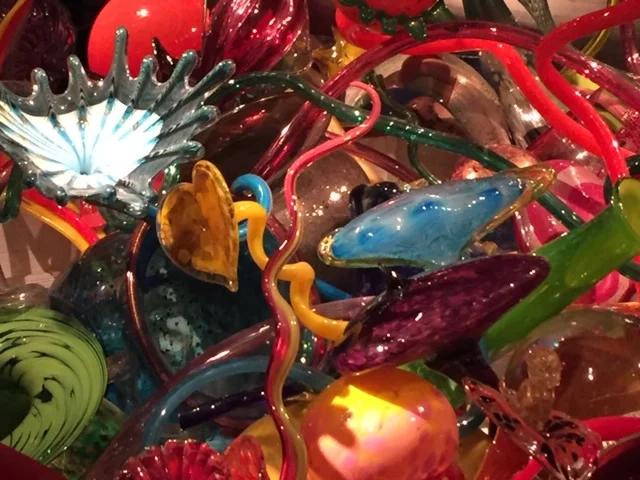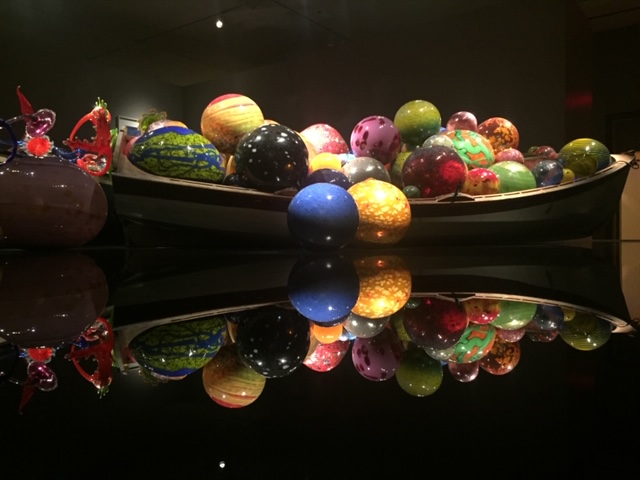Oklahoma City – Revisited – Part 3
Another Day with Dale Chihuly – Magic & Light
Wednesday, August 22, 2018
Clear, 92°
“Glass is the most magical of all materials. It transmits light in a special way."
-Dale Chihuly
After seeing Dale Chihuly’s work at the Atlanta Botanical Gardens, and the Seattle’s Chihuly Gardens and Glass next to the Space Needle, it was a no brainer to see his exhibit at the Oklahoma City Museum of Art.
Is there any more beautiful artwork than light streaming through colored glass? Think stained glass windows. Think Tiffany lamps. And think Dale Chihuly, creator of huge colorful glass sculptures in varying shapes and textures. One of the largest collections of Chihuly glass is on permanent exhibit at the Oklahoma City Museum of Art.
In 2002, the Oklahoma City Museum of Art inaugurated its new home in the Donald W. Reynolds Visual Arts Center with an exhibition of glass and drawings by Dale Chihuly. Bolstered by enormous public support, the Museum purchased the exhibition, which included works from Chihuly’s best-known series and was anchored by the 55-foot Eleanor Blake Kirkpatrick Memorial Tower in the Museum’s atrium.
Redesigned in collaboration with Chihuly Studio, the galleries incorporate a unique design that features a three-dimensional approach to viewing some objects in the collection. The presentation allows visitors to explore the large Float Boat and Ikebana Boat installations from all sides as well as includes viewing slots for the Reeds.
Chihuly’s work is included in over 200 museum collections, including the Oklahoma City Museum of Art, and he has received world renown for his extensive glass series, international projects, and large architectural installations such as the Museum’s Eleanor Blake Kirkpatrick Memorial Tower. The Museum’s collection represents over three decades of Chihuly’s finest work and heralds this brilliant luminist as the most important artist working in glass since Louis Comfort Tiffany. (okcmoa.com)
This exhibit captures your attention as soon as you walk into the museum’s door as just inside in the atrium is the 55 foot Eleanor Blake Kirkpatrick Memorial Tower, (2002), which sets you up for the breathtaking display to come shortly, once you are in the galleries. The Tower, 2400 individual hand-blown glass tubes in yellows and blues twist and curl together, soaring 55 feet up the museum’s three-story entry atrium, hinting at what awaits you in the third-floor exhibit.
Eleanor Blake Kirkpatrick Memorial Tower
The Oklahoma City Museum of Art has one of the largest collections of Chihuly glass in the world. Originally titled Dale Chihuly: An Inaugural Exhibition, which showed in 2002, the Museum eventually purchased the entire collection in June 2004 and later re-titled it Dale Chihuly: The Collection. The collection also includes later gifts to the Museum by Dale Chihuly and the installation was modified again in 2015 and relaunched as Dale Chihuly: Magic & Light. (newsok.com)
The first room we entered was “The Reeds”, lovely long purple glass pieces that were embedded into several logs; the light gave a very serene feel to the exhibit. It was a great way to start the exhibit.
The Reeds
Chihuly made the first Reeds in Finland in 1995. To make them, one glassblower climbs onto a mechanical lift while holding the gather of glass on the blowpipe and blows into the glass while another person on the ground pulls it from below. Some Reeds are longer than 10 feet.
“During the planning of the inaugural Dale Chihuly exhibition at the Oklahoma City Museum of Art, a large storm brought down trees at the house of the Museum’s then-director Carolyn Hill,” Shotick said. “After being treated for insects or mold, the tree trunks were brought in and used as the base for the Reed installation, adding a piece of Oklahoma to the exhibition.” (newsok.com)
The next room had many pedestals, each with a beautifully lit bowl. There were many colors reflected in the bowls; reds, blues, yellows, and greens are just a few of the vibrant hues.
The Macchia Bowl Room
The next room had a whimsical feel about it. The Confetti Anemone Wall, 1999, has blown glass art of many different colors, with ridges on the glass and many twisted layers, giving the pieces a beautiful playful look.
Confetti Anemone Wall pieces
Next up, was the room with the Autumn Gold Persian Wall, 2002. These were large orange and red fan looking pieces; some hung from the wall while others were on polished black bases about eight inches off the floor creating reflections of the pieces above. The detail in the glass with the different patterns in them is stunning. There were also Tiger Lilies at a right angle to the Autumn Gold Persian Wall.
Autumn Gold Persian Wall pieces
Just when you think there can be no more surprises, you come to the Persian Ceiling, a passageway that entices you to look nowhere but up. Going from one room to another was a corridor with the Oklahoma Persian Ceiling, 2002, and Twilight and Aurora Persian Set, 2004. This beautiful ceiling displays colorful pieces of glass in a mosaic above the glass ceiling.
Persian Ceiling
The Persian series is an eccentric collection of brightly colored and unusually shaped glass pieces. “The series started with small and experimental geometric shapes - primarily small bottles and vessels,” Shotick said. “Gradually, Chihuly pushed his Persians into large fluted shapes, which are then often grouped with the smaller vessels.” “If you look closely at the glass-filled ceiling, you can see five putti. Italian for ‘little boys,’ putti are imaginary winged figures that were often used as decoration in Renaissance and Baroque art,” Shotick explained. (newsok.com)
Persian Ceiling
For me the Seal Pups, 2002, were a little odd with the logs and what to me looked like long red and black water balloons. It seemed out of place with the other exhibit pieces. Pretty to look at but confusing, in a way.
Seal Pups pieces
The orange baskets here reminded me of the ones in Seattle, which were with the Native American display. There, Chihuly’s glass baskets were displayed along with native woven baskets in Chihuly’s personal collection. The lighting gave color and texture to the walls and floor enhancing the display.
Orange Baskets
My favorite room was the Float Boat & Ikebana Boat display.
Boats - Yellow glass in forefront
The boats sitting on the polished black floor gives the light and reflective qualities another dimension.
Float Boat - Glass Balls reflected in polished floor
What was really great about this was the full 360° access the viewer has to the boats. You may walk all around them seeing different forms and colors from every angle. The dark room with the brightly lit balls is completely mesmerizing.
Float Boat exhibit – Yellow & Blue Ball on right
Perhaps the most intriguing pieces of the collection, the glass-filled boats are especially beloved for their whimsical qualities. But their story is equally intriguing.
Chihuly first filled boats with glass in Nuutajärvi, Finland, while working on a collaborative project for the exhibition “Chihuly Over Venice” in 1995, Shotick explained. After several days of glassblowing, the artist and his team made temporary installations along the Nuutajoki River.
“Liking the way the glass looked in water, he tossed pieces into the river, letting them float downstream,” Shotick said. “Local children in small wooden rowboats joined in and gathered the floating glass for him, and it was then that Chihuly saw the opportunity for a new type of installation.”
She also said that the team found a partially submerged wooden rowboat along the riverbank, which was hauled out and emptied of mud and debris, and Chihuly filled it with glass. “He has continued to revisit the boat idea ever since,” Shotick added. (newsok.com)
Chihuly worked with Italian glass master Pino Signoretto on this series, to add classical solid glass figures to contemporary blown glass vessels. The name Putti was inspired by the frolicking cherubs featured in their earliest pieces. Since then, Putti has expanded to include vessels with a range of mischievous figures, such as birds, mammals and sea creatures. (chihuly.com/work/putti)
The Putti Room was filled with beautiful pieces showing the various intricacies of birds on numerous colored vessels.
Putti Room Pieces
The Ikebana Room had colorful pieces displayed against a back-lit wall on a black polished base.
Ikebana Room Pieces
Ikebana vases with flowers
The Blue Baskets Sets
The glass work exhibit is just amazing. It is hard to imagine the huge tower in the museum entryway, how much work went into planning, creating and assembling it. The glass ceiling, the boats, and other glass works are all impressive. Seeing the Chihuly collections all over the country gives a sense of inspiration to the possibilities of what one can do in any medium or field of endeavor.
Go see this beautiful collection of blown glass, the vibrant colors and the endless surprises of what you will see at the Oklahoma City Museum of Art will not disappoint. There are other collections that are showcased on the multiple floors of the museum giving a nice variety of artwork, displays, and interactive exhibits, for the visitor to enjoy.

















